Overview:
This will make an Air Tech 2000 have a 3-round breech magazine, and be capable of ranges up to 120’. All steps have been thoroughly tested.
Difficulty:
3 out of 5
Materials:
-Air Tech 2000
-12” ½” of CPVC, cut into 4” and 8”
-1 ½” CPVC coupler
-4” of PVC, cut into 1”, 1”, and 2”
-A Dremel multi-tool
-Sandpaper
-2 pieces of 2”x1.6”x~1mm balsa wood
-Hot glue gun with plenty of hot glue
-A Philips screwdriver
-Black Sharpie
-Hammer
-Pliers
Procedure:
AT2K:
Take apart the Air Tech 200. Slide out the pump, and plug the overpressure release valve with hot glue. Set the shaft aside to dry.
Take all of the screws out of the Liquitron Power gauge and empty the liquid. Screw it back together, making sure that the rubber seal is in place.
See those little pieces that make sure the front of the air tank doesn’t wiggle on each side of the case? Take your pliers and rip them off.
Take the turret out. Do whatever you want with it; it’s not needed.
Keep your gun apart.
Action:
Take the 4” piece of CPVC and hot glue the coupler onto it. Allow to dry.
Take the 2” piece of PVC and using the largest Dremel sanding bit, sand out the inside so that a piece of ½” CPVC can slide through easily.

Switch the sanding bit on the Dremel to the circular hard disc.
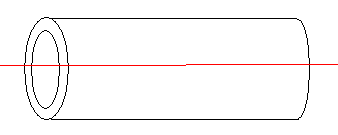
Using that, cut the PVC in half lengthwise so you end up with 2 pieces that are 2” long. Set one aside.
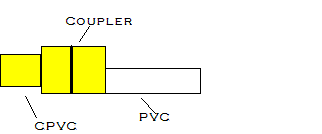
Hot glue the other piece to the CPVC coupler, making sure that there is no glue in the way of a piece of CPVC fitting into the coupler. Allow to dry.
Take one of the 1” pieces of ½” PVC and, switching Dremel bits back to the large sanding one, sand out the inside so that ½” CPVC could fit easily through.

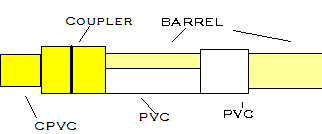
Attach this to the end of the 2” piece that is attached to the coupler. To ensure straightness, slide the 8” piece of CPVC through so that it attaches to the coupler, NOT GETTING ANY GLUE ON IT. Allow to dry.
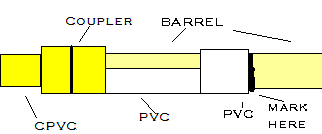
At the end of the PVC, take the sharpie and draw a line around the CPVC that marks where it meets the end of the PVC. Remove the CPVC.
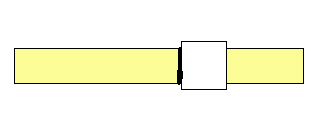
Take your remaining 1” piece of PVC and hammer it onto the ½” CPVC until it reaches the black sharpie mark. (When you put the CPVC back into the action, it should still make a seal with the coupler.)
Your action is complete.
The Magazine:
Take the CPVC out of the action and set it aside.
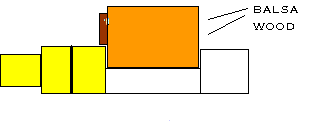
Take your two pieces of 2”x1.6”x~1mm balsa wood and hot glue them straight between the coupler and 1” PVC. Allow to dry.
Take the piece of 2” PVC that you previously Dremeled and cut in half lengthwise, and switch Dremel bits back to the cutting-disc. Cut the piece in half so that you end up with two 1” pieces of PVC that are cut in half.
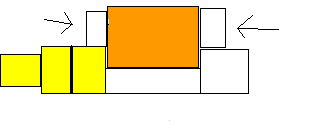
Glue one to the balsa wood and coupler, and the other to the balsa wood and PVC. Allow to dry.
Turn the action sideways so that one piece of balsa wood is down and the other is up; both are horizontal.
Take your hot glue gun and cover the balsa wood with hot glue. Allow to dry.
Flip the action and repeat with the other side of the balsa wood. Allow to dry.
Completion:
Take the airtank of your AT2K and cover this part with hot glue.

Slide the end of the action with 2” of CPVC onto it, and smother the connection with more hot glue, making sure that the barrel is pointing STRAIGHT. Allow to dry.
Put the airtank/pump/trigger+ action back into the AT2K case.
Screw the case together.
Point the gun so that the barrel is facing you.
See the part right above the pump handle where the CPVC and AT2K touch?
Align the barrel and smother that part with hot glue. Allow to dry STRAIGHT.
You are done! To work:
Pull the 8” barrel forward.
Load three 2” darts into the action (it is advisable to make some type of removable cap to cover the action to darts don’t fall our when you move).
Pull the 8” barrel back, chambering a dart.
Pump, fire.
Pull the 8” barrel forward then back.
Pump, fire.
Repeat.
**A Sinfil Production***
-SInnER-
Edited by Sinfil, 20 November 2005 - 07:46 AM.























